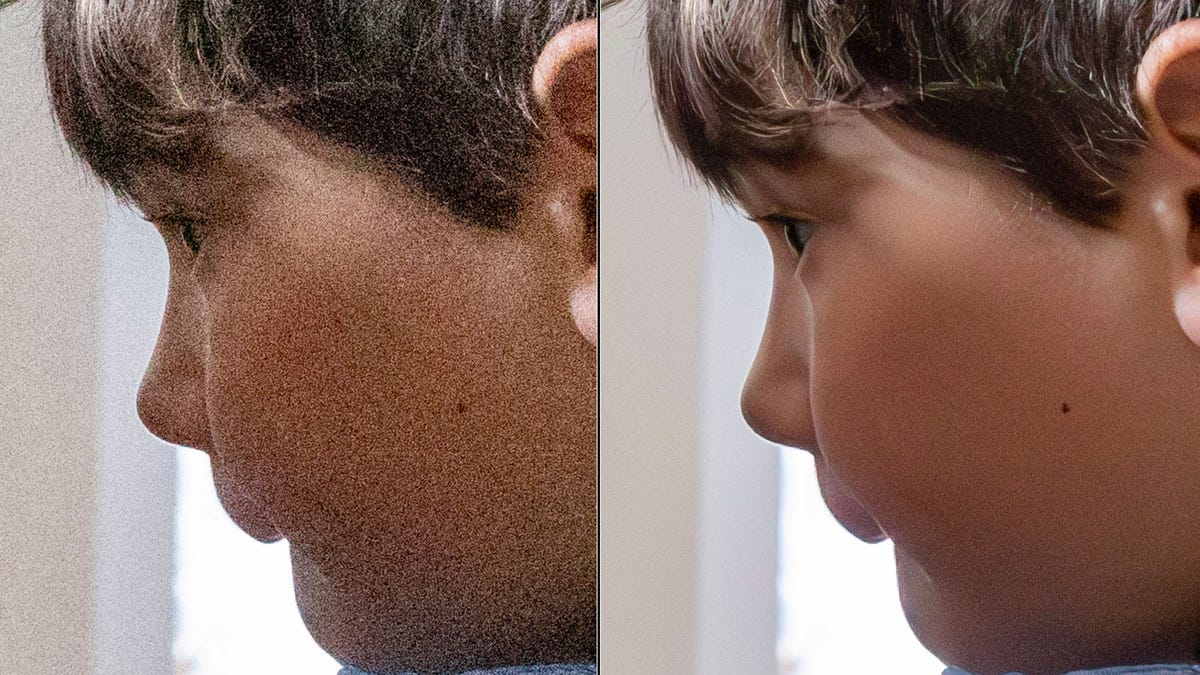Adobe Lightroom AI Feature Tackles a Massive Photo Problem
A new denoise feature should make photographers happier to shoot in dim conditions and push photo editing a little further.

Lightroom can dramatically reduce image noise speckles with an AI-based system trained on real-world photos.
With an update Tuesday to its Lightroom software, Adobe has applied AI technology to one of digital photography's most persistent problems: multicolored speckles of image noise. It's not always perfect, but it works and sometimes can even salvage otherwise terrible photos.
Digital photos taken in dim conditions are often plagued with noise, especially when you need a fast shutter speed to avoid blur with moving subjects. But Adobe trained an artificial intelligence model to clean up photos, adding it as a new feature called denoise.
It's a notable example of how AI can breathe new life into older software and services. Microsoft, Google and other companies have the same idea with improvements planned for tools like searching with Bing, writing with Word and drafting emails with Gmail.
I've been trying Adobe's denoise AI feature in a prerelease version of Lightroom and can confirm it works, in some cases impressively. It rescued portraits by smoothing skin while preserving hair detail in photos I took at dawn with my DSLR at a very high ISO 25,600 sensitivity setting.
A shot of my mom lit only by birthday candle light likewise was significantly improved. I also found it useful on photos of birds, wooden carvings in dim European cathedrals and Comet Neowise in the night sky in 2020. It's particularly useful for improving photos that I'll never be able to reproduce, like a shot of my young son reading an ebook in the dark, lit only by the glow of a phone screen.
It's not perfect. Skin can look plasticky and artificially smooth, especially if you crank up the noise removal slider too far. Sometimes it seemed to inject a sort of motion blur detail. Pairs of thin cables stabilizing San Francisco's Sutro Tower were distorted into wispy streamers.
Based on my early tests, though, I think Lightroom's denoise feature is useful enough to make photographers feel more comfortable shooting at high ISO and to give them more latitude in editing, for example brightening shadowy areas of photos. And Lightroom's denoise feature is built straight into Lightroom.
"Our overall goal right now is to make it really easy for anyone to edit photos like a pro, so that they can really achieve their creative vision," said Rob Christensen, Adobe's product director for Lightroom. "AI is a true enabler for that."
Lightroom's AI-powered denoise feature was able to cut noise while preserving details in this bird's plumage.
Lightroom isn't the first to embrace AI for noise reduction. Topaz DeNoise and the newer Photo AI from Topaz Labs has attracted a following, for example, among bird photographers who routinely struggle with high noise that often accompanies high shutter speeds. Photo AI also has AI-based sharpening tools that Adobe's Lightroom and Photoshop lack.
Google, an AI and computational photography leader, uses AI to reduce noise when its Pixel phones use Night Sight to take shots in the dark. And DxO's PureRaw and PhotoLab software has used AI denoising technology since 2020.
Artificial intelligence technology today typically refers to systems that are trained to recognize patterns in complex real-world data. For the denoise tool, Adobe created pairs of millions of photos consisting of a low-noise original and a version with artificial noise added. Although Adobe generated the noise artificially, the company based it on real-world noise profiles from actual cameras, Adobe engineer and fellow Eric Chan said in a blog post.
"With enough examples covering all kinds of subject matter, the model eventually learns to denoise real photos in a natural yet detailed manner," Chan said.
Lightroom denoise limitations
The denoise tool has some limitations. It works only on raw images, though JPEG support is in the works, Christensen said. And it doesn't yet support all cameras, including raw shots from Apple iPhones and Samsung Galaxy phones I tested. My Pixel 7 Pro's raw images worked, though.
Lightroom's Denoise feature cleaned up this very noisy photo of a soaring California condor.
Another caveat: The denoise tool creates a new DNG image. That's because it creates new pixel-level detail, Christensen said. It's not a reversible change like most of what you can do with Lightroom's nondestructive editing process.
Most photographers testing the denoise tool prefer to use it early in the editing process, Christensen said. That makes sense to me, since editing choices like boosting brightness in shadowy areas can be limited by noise.
If you prefer Lightroom's earlier tools, they're still available in a "manual noise reduction" section below the new denoise button. The denoise tool is available in Lightroom and Lightroom Classic, where it takes advantage of AI acceleration hardware built into newer processors, but not on the mobile versions for phones and tablets.
Other new Lightroom abilities
The new version of Lightroom adds some other tricks:
- You can now edit selected areas of a photo with Lightroom's tone curve tool.
- Lightoom's AI-powered selection tools now can detect facial hair and clothing so you can edit just those portions of an image.
- Adobe added three new adaptive presets, AI-boosted tools for specific situations like whitening teeth. One applies a range of changes to portraits, smoothing skin and adjusting lighting. The others make clothes more colorful, and the other darkens beards.
- Lightroom now supports a preview version to test the Content Authenticity Initiative's ability to record editing changes within photo metadata called content credentials. The technology is designed to help bring more transparency and trust in a world of doctored and now AI-synthesized photos.
- Lightroom's new AI-powered masking tools, which let you select photo regions like skies or a subject's face, now work on the web-based version of Lightroom.
- You can change videos into black and white if you want a more artsy or retro look.

